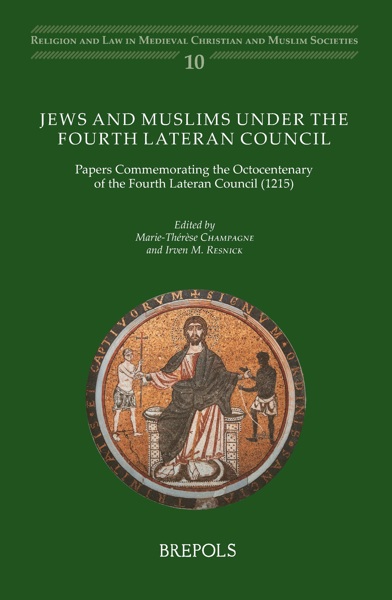
Jews in Early Christian Law
Byzantium and the Latin West, 6th-11th centuries
John V. Tolan, Nicholas de Lange, Laurence Foschia, Capucine Nemo-Pekelman (eds)
- Pages: 379 p.
- Size:156 x 234 mm
- Language(s):English, French
- Publication Year:2014
- € 85,00 EXCL. VAT RETAIL PRICE
- ISBN: 978-2-503-55052-7
- Paperback
- Available
- € 85,00 EXCL. VAT RETAIL PRICE
- ISBN: 978-2-503-55124-1
- E-book
- Available
“Insgesamt besticht der Band durch die regionale und sachliche Breite der behandelten Komplexe. Daneben veranschaulicht er auch einige wesentliche methodische Probleme in der Erforschung des Zusammentreffens christlicher Mehrheitsgesellschaft und jüdischer Minderheit im Mittelalter. Über die hier beanstandete Einseitigkeit des Verständnisses der wenigen vorliegenden Quellen wird, auch und gerade mit Hilfe dieses Bandes, in der Zukunft zu diskutieren sein.” (Michael Toch, in: Francia-Recensio, 2015/1)
"Es ist eine Stärke des Sammelbandes, sich nicht ausschliesslich - wie mehrere andere rechtshistorische Darstellungen - auf die Normative Ebene von Gesetzestexten zu beschränken, sondern auch danach zu fragen, was diese normativen Quellen über die konkreten Lebensbedingungen der Juden aussagen. Eine weitere Stärke liegt zweifelsohne darin, lateinischen 'Westen' und byzantinischen 'Osten' vergleichend in den Blick zu nehmen." (C. Scholl, in: Das Mittelalter 20, 2 (2015), p. 450-451)
« Ainsi, ce volume, tout en apportant une lumière qui manquait sur ces siècles « obscurs », en tout cas mal connus et difficiles à connaitre (…) est-il aussi l’occasion d’une réflexion approfondie sur l’usage que l’historien peut faire de divers types de sources juridiques. Historia utens et historia docens, en quelque sorte, une double leçon deux fois précieuse. » (Jean-Pierre Rothschild, dans la Revue des études juives, 175/3-4, 2016, p. 465)
“John Tolan’s decision to turn the history of law into the subject of a series dealing with ‘religious minorities’ during the Middle Ages is most welcome (…) The fact that this volume and indeed the whole series provoke these questions is one of its merits.” (Britta Müller-Schauenburg, in Journal of the Transcultural Medieval Studies, 4/1-2, 2017, p. 325-328)
The sixth to eleventh centuries are a crucial formative period for Jewish communities in Byzantium and Latin Europe: this is also a period for which sources are scarce and about which historians have often had to speculate on the basis of scant evidence. The legal sources studied in this volume provide a relative wealth of textual material concerning Jews, and for certain areas and periods are the principal sources. While this makes them particularly valuable, it also makes their interpretation difficult, given the lack of corroborative sources.
The scholars whose work has been brought together in this volume shed light on this key period of the history of Jews and of Jewish-Christian relations, focusing on key sources of the period: Byzantine imperial law, the canons of church councils, papal bulls, royal legislation from the Visigoths or Carolingians, inscriptions, and narrative sources in Hebrew, Greek and Latin. The picture that emerges from these studies is variegated. Some scholars, following Bernhard Blumenkranz, have depicted this period as one of relative tolerance towards Jews and Judaism; others have stressed the intolerance shown at key intervals by ecclesiastical authors, church councils and monarchs.
Yet perhaps more than revealing general tendencies towards "tolerance" or "intolerance", these studies bring to light the ways in which law in medieval societies serves a variety of purposes: from providing a theologically-based rationale for social tolerance, to attempting to regulate and restrict inter-religious contact, to using anti-Jewish rhetoric to assert the authority or legitimacy of one party of the Christian elite over and against another. This volume makes an important contribution not only to the history of medieval Jewish-Christian relations, but also to research on the uses and functions of law in medieval societies.
Capucine Nemo-Pekelman & Laurence Foschia, Introduction
I Rank and status of Jews in civil and canonical law
1. Ralph W. Mathisen, The Citizenship and Legal Status of Jews in Roman Law during Late Antiquity (ca. 300-540 CE)
2. Céline Martin, Statut des juifs, statut de libre dans l’Occident du haut Moyen Âge : l’exemple ibérique
3. David Freidenreich, Jews, Pagans, and Heretics in Early Medieval Canon Law
II - Lawyers at work : from the adaptation of Roman Law to the creation of canonical collections and false canons
4. Bruno Judic, Grégoire le Grand et les juifs. Pratique juridique et enjeux théologiques
5. Jessie Sherwood, Interpretation, negotiation, and adaptation: Converting the Jews in Gerhard of Mainz’s Collectio
6. Philippe Depreux, Les juifs dans le droit carolingien
7. Capucine Nemo-Pekelman, Signum mortis : une nouvelle explication du signe de la rouelle ?
III - Juridical sources as indications of Jewish life and institutions?
8. Alexander Panayotov, Jewish Communal Offices in Byzantine Law and Jewish Inscriptions from the Balkans
9. Bat-Sheva Albert, Les communautés juives vues à travers la législation royale et ecclésiastique visigothique et franque
10. Raul González-Salinero, The Legal Eradication of the Jewish Literary Legacy in Visigothic Spain
11. Johannes Heil, Getting them in or Keeping them out? Theology, Law, and the Beginnings of Jewish Life at Mainz in the 10th and 11th centuries
IV - From the Law to Violence, from Violence to Law
12. Paul Magdalino, ‘All Israel will be saved’? The forced baptism of the Jews and imperial eschatology
13. Rachel Stocking, Forced Converts, “Crypto-Judaism,” and Children: Religious Identification in Visigothic Spain
14. María Jesús Fuente, Jewish Women and Visigoth Law
15. Oscar Prieto Dominguez, The mass conversion of Jews decreed by Emperor Basil I in 873: its reflection in contemporary legal codes and its underlying reasons
16. Amnon Linder, The Jewish Oath
Nicholas de Lange and John Tolan, Conclusion




